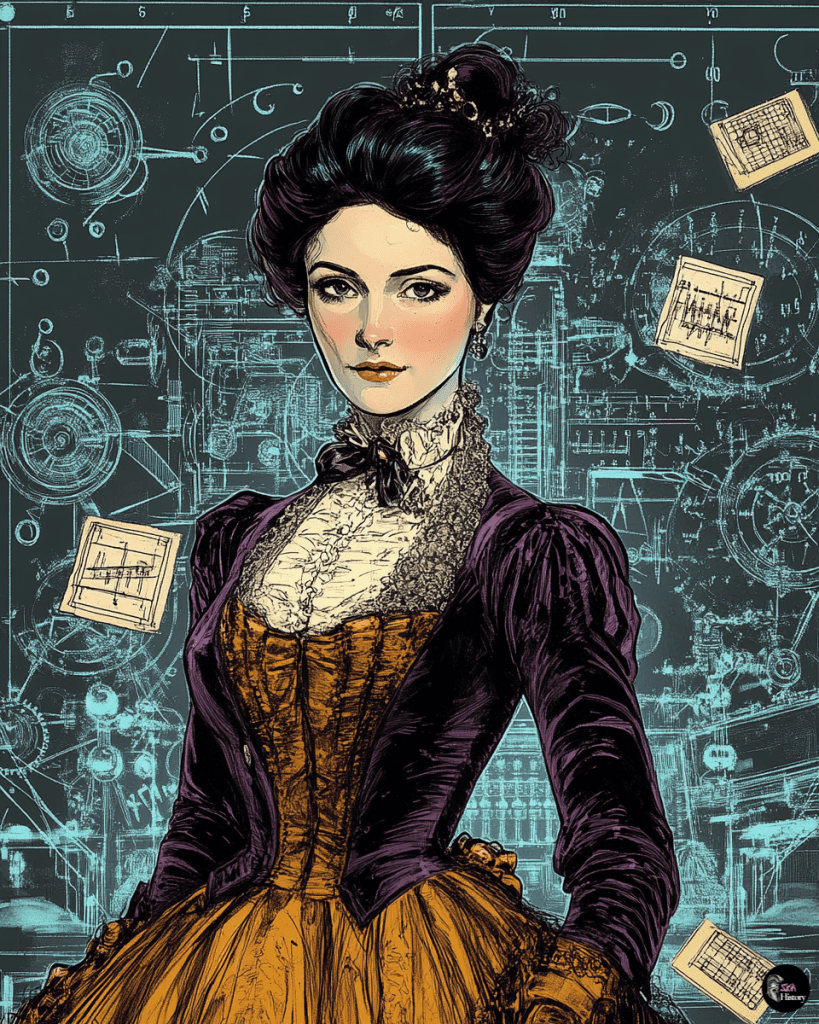Ada Lovelace, born Augusta Ada Byron in 1815, stands as a pioneering figure in the realm of computer science. She is widely recognized as the world’s first computer programmer, having written an algorithm for Charles Babbage’s Analytical Engine in the mid-1800s. This remarkable achievement came at a time when the concept of computers was still in its infancy, making her contributions all the more extraordinary.
The daughter of the famous poet Lord Byron, Ada’s life was shaped by an unusual upbringing that fostered her love for mathematics and logic.
Her mother, Lady Annabella Milbanke Byron, emphasized mathematics in Ada’s education to counteract what she perceived as the dangerous poetic tendencies inherited from her father.
This unique blend of artistic heritage and scientific education would prove instrumental in Ada’s groundbreaking work.
Ada’s collaboration with Charles Babbage on the Analytical Engine led to her most significant contribution to the field of computing. Her notes on the engine included what is now considered the first computer program, a method for calculating Bernoulli numbers.
Beyond this, she envisioned the potential of computers to go beyond mere calculation, foreseeing their capability to manipulate symbols and even create music. Her visionary ideas laid the groundwork for the digital age we live in today.
Early Life and Education
Ada Lovelace’s upbringing was shaped by her aristocratic heritage and a unique blend of artistic and scientific influences.
Intellectual pursuits marked her early years, and the guidance of accomplished tutors set the stage for her future contributions to mathematics and computing.
Aristocratic Heritage
Ada Lovelace was born Augusta Ada Byron on December 10, 1815, in London, England. She was the only legitimate child of the famous poet Lord George Gordon Byron and his wife, Anne Isabella Milbanke. Her mother, a talented mathematician herself, came from a noble family.
Ada’s parents’ tumultuous marriage ended just weeks after her birth, and she never knew her father.
Lady Byron, determined to steer her daughter away from what she perceived as her father’s unstable temperament, cultivated Ada’s interest in mathematics and logic from an early age.
Passions and Tutors
Ada’s education was far from typical for a young woman of her time.
Lady Byron engaged a series of tutors to nurture her daughter’s intellect, including Mary Somerville, a renowned Scottish astronomer and mathematician who became Ada’s mentor and friend.
Despite her mother’s efforts to suppress Ada’s creative side, the young girl developed a passion for both science and poetry.
She demonstrated a remarkable aptitude for numbers and language, studying various subjects, including French and music.
At age 12, Ada conceived a design for a flying machine, showcasing her early inventive spirit.
Ada’s fascination with machines and mechanisms grew alongside her mathematical skills. This unique combination of interests would later prove instrumental in her work on Charles Babbage’s Analytical Engine.
Contributions to Computing
Ada Lovelace’s groundbreaking work in the mid-19th century laid the foundation for modern computer programming. Her collaboration with Charles Babbage and visionary insights into the potential of computing machines revolutionized the field of mathematics and technology.
Work with Charles Babbage
Ada Lovelace first met Charles Babbage in 1833 when she was just 17 years old.
Their intellectual partnership blossomed over the years, with Lovelace taking a keen interest in Babbage’s inventions. His Difference Engine, a mechanical calculator designed to produce mathematical tables fascinated her.
Lovelace’s mathematical prowess and creative thinking complemented Babbage’s engineering skills.
The Analytical Engine
Lovelace’s most significant contribution to computing came through her work on the Analytical Engine. This theoretical machine, conceived by Babbage, was designed to perform complex calculations and is considered a precursor to modern computers.
In her notes on the Analytical Engine, Lovelace demonstrated remarkable foresight.
She envisioned the machine’s potential beyond mere number crunching, suggesting it could manipulate symbols and even create music. This insight laid the groundwork for the concept of general-purpose computing.
Lovelace’s notes included an algorithm for calculating Bernoulli numbers using the Analytical Engine. This algorithm is widely recognized as the world’s first computer program, earning her the title of the first computer programmer.
Legacy and Honors
Ada Lovelace’s contributions to computing have gained widespread recognition in recent decades.
Her visionary work has inspired generations of scientists, mathematicians, and computer programmers.
In her honor, the U.S. Department of Defense named a programming language “Ada” in 1979.
This high-level language is still used in aviation, healthcare, transportation, and space industries.
Ada Lovelace Day, celebrated annually on the second Tuesday of October, commemorates women’s achievements in science, technology, engineering, and mathematics (STEM).
This event encourages young women to pursue careers in these fields, carrying forward Lovelace’s pioneering spirit.
Lovelace’s life and work continue to inspire books, films, and academic studies, cementing her place as a pivotal figure in the history of computing.

